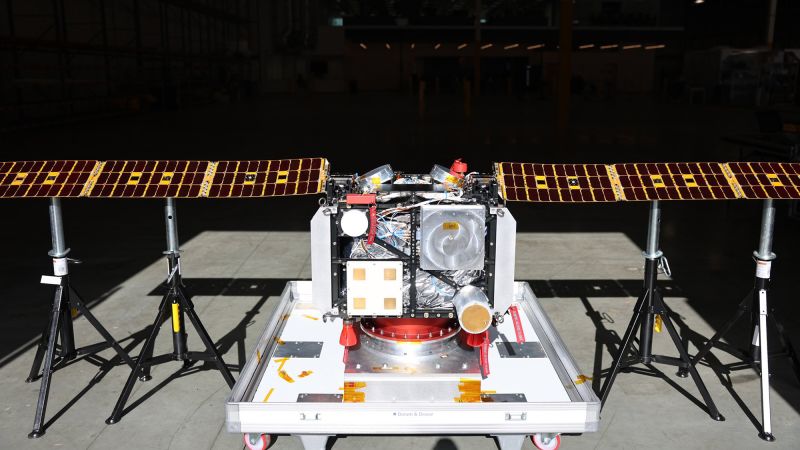In the realm of space exploration, the frontier of asteroid mining has recently gained significant attention, particularly with the emergence of innovative startups like AstroForge. Co-founded by engineer Matt Gialich in 2022, AstroForge is on a mission to unearth precious metals from asteroids. Gialich, who now serves as the CEO of the company, is acutely aware of the ambitious nature of this venture, recognizing the multitude of challenges that lie ahead. His venture may seem audacious, yet it is driven by a deep-seated belief in the potential of commercial space travel.
The nature of Gialich’s mission is deeply intertwined with feelings of apprehension and fear. In a candid video interview with CNN, he expressed his genuine concerns about the risks involved, stating bluntly, “I’m f**king terrified.” This candid admission reflects the gravity of the task at hand, as AstroForge prepares to launch its robotic spacecraft, Odin, on a groundbreaking asteroid flyby mission. Scheduled for launch aboard a SpaceX Falcon 9 rocket from NASA’s Kennedy Space Center in Florida on February 26, 2024, this mission marks AstroForge’s initial foray into the promising yet perilous domain of asteroid mining.
Odin, a compact spacecraft roughly the size of a window air-conditioning unit, has been developed in an impressively short timeframe of just ten months. According to Gialich, “if you’re not scared when we launch, we went too f**king slow.” This mantra encapsulates the company’s ethos of embracing fear as a catalyst for innovation and success. The Odin spacecraft will embark on a journey that includes a close approach to its target asteroid, 2022 OB5, which is expected to pass near Earth at a distance of around 403,000 miles (or 649,000 kilometers).
AstroForge aims to determine whether 2022 OB5 is an M-type asteroid, believed to be rife with platinum—a resource both rare and valuable on Earth. The company plans to utilize the optical camera onboard Odin to take photographs of the asteroid, which will then be analyzed for signs of platinum. Should the findings confirm the presence of this coveted metal, future missions could potentially aim to extract and transport the mined resource back to Earth, where platinum is crucial in various industries, including electronics and pharmaceuticals.
The ambitious aims of AstroForge come with considerable risk, as previous attempts at asteroid mining made by companies like Planetary Resources and Deep Space Industries have not reached fruition. Past efforts, especially governmental missions like NASA’s OSIRIS-REx, have proven to be hugely expensive undertakings, costing hundreds of millions of dollars for minimal returns. In contrast, AstroForge estimates the cost of its maiden reconnaissance mission at less than $7 million. This financial strategy could alter the landscape of asteroid mining, as the company aims to operate at a fraction of the cost associated with traditional governmental space endeavors.
The pioneering spirit behind AstroForge is fueled by an underlying philosophy: to stimulate the private space sector towards ambitious endeavors that could ultimately reduce the costs of space travel and exploration. Gialich, in alignment with this vision, is not only driven by the prospect of success but also seeks to encourage a forward momentum in space exploration. He believes that even if AstroForge doesn’t achieve its specific mission objectives, its efforts could open doors for future ambitions in the field.
The prospect of asteroid mining poses several legal and ethical questions. For example, while the 1967 Outer Space Treaty establishes that space is “the province of all mankind,” it doesn’t clearly address the ownership of resources mined from asteroids. This ambiguity has led to variations in space laws across nations, with countries like the United States, Japan, Luxembourg, and the United Arab Emirates establishing legal frameworks that allow private companies to claim ownership over materials extracted from space.
Gialich acknowledges that there are significant unknowns regarding the viability of asteroid mining. With concerns about whether missions will be cost-effective and the complexities surrounding potential competition for the same asteroids, the challenges are manifold. Furthermore, as AstroForge moves closer to its launch date, the need for collaboration with the scientific community has become evident. Members of the astronomical community have urged AstroForge to disclose its mission plans more transparently to avoid miscommunication and wasted resources.
As Gialich reflects on the path ahead for AstroForge, he remains committed to the overarching goal of inspiring change in the space industry. By challenging traditional methods and encouraging innovative approaches, he hopes to pave the way for a new era of commercial astrological endeavors. The launch of Odin may not only represent a significant step for AstroForge but also a pivotal moment for the future of private sector space exploration—and the quest for resources beyond our planet.












